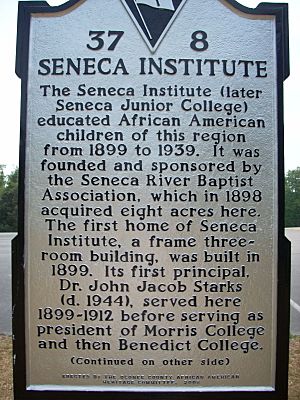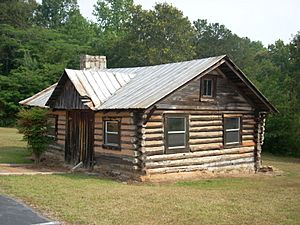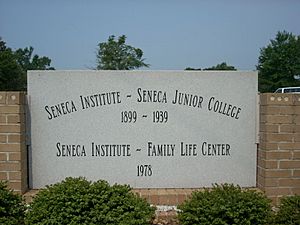Seneca Institute – Seneca Junior College facts for kids
The Seneca Institute – Seneca Junior College was a special school for African American students. It was located in Seneca, South Carolina. This school operated from 1899 to 1939. During this time, schools in South Carolina were segregated, meaning Black and white students went to separate schools.
Contents
History of the School
The Seneca Institute opened in 1899. It was a Christian school for African American children. It offered both primary (elementary) and secondary (high school) classes. The Seneca River Baptist Association started the school. It was built on about 8 acres of land in Seneca, South Carolina. The school was very important because there was no high school for African American students in Oconee County, South Carolina at that time.
First President
The first president of the Seneca Institute was Rev. Dr. John Jacob Starks. He was born in what is now Greenwood County, South Carolina. Dr. Starks led the Seneca Institute for thirteen years. He then left to become the president of Morris College in Sumter, South Carolina. Later, he became the president of Benedict College in Columbia, South Carolina. He served there until he passed away.
Becoming a Junior College
In 1926, the school added two years of college-level classes. Because of this, its name changed to the Seneca Junior College. Besides elementary and high school classes, it also offered a junior college program. This program helped train new teachers.
In 1937, a special library called the Faith Cabin Library was built on the campus. Students from Oberlin College donated the books for this library.
School Closure
The school faced many challenges during the Great Depression. This was a time when many people had little money. Because of these difficulties, the Seneca Junior College closed its doors in 1939.
Campus Buildings
Students at the Seneca Institute could live at the school or come from nearby homes. The campus had a brick dormitory for girls. There was also the B.S. Sharp Dormitory for boys. Classes were held in the A.P. Dunbar Hall. The school also had a library. Most of the buildings were taken down in 1963. However, the log cabin library is still standing today.
Other African American Schools
During the time when schools were segregated, other private and public schools also served African American students in Oconee County.
Norrel School
The Norrel School was started by Northern Presbyterians. It began as both a church and a school. This school closed before 1939.
Oconee County Training School
The Oconee County Training School was a public school for African Americans. It opened in 1925. This school focused on training teachers. It also taught subjects like home economics, industrial arts, and farming. In 1955, its building became the East End Elementary School.
Blue Ridge High School
Blue Ridge High School was built in 1955. It served the African American community in Seneca. This school continued to be the high school for African American students until 1969. That year, all public schools in the county became integrated, meaning students of all races could attend together. The building was later renamed Seneca Junior High School and then Code Elementary School.
Lasting Impact
The Seneca Institute – Seneca Junior College helped educate many African Americans. These students went on to become important people in the Seneca area and across the country. Many became doctors, dentists, religious leaders, and teachers.
In 1978, a new building was dedicated on the old campus. It is called the Seneca Institute Family Life Center. This building serves as a community center for everyone.




